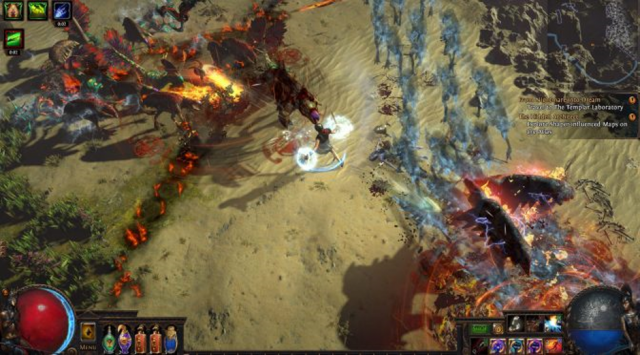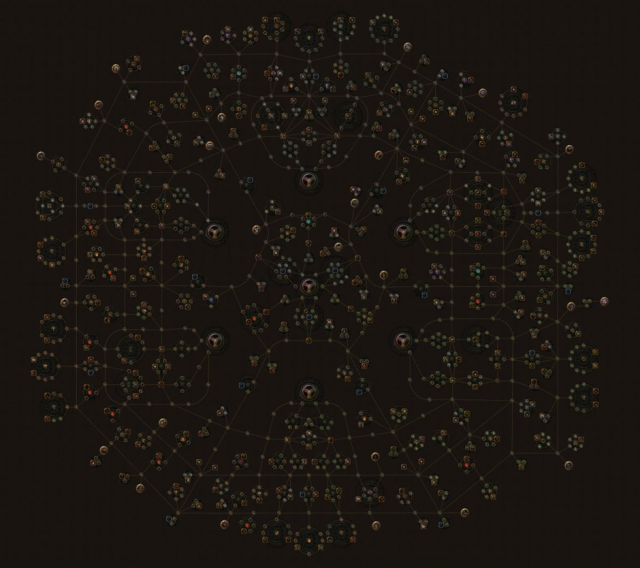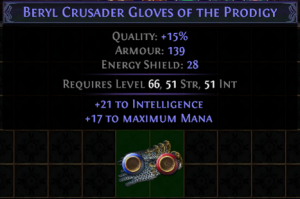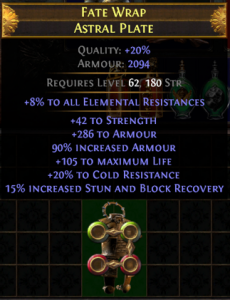
Path of Exile is a top-down 3rd person online Action Role Playing Game with a fantasy setting. Players work solo or in a team and progress through the story, gathering items to make their characters stronger. Similar games include Diablo 3 and Grim Dawn.
Game’s website: https://www.pathofexile.com/
Latest league trailer: https://www.youtube.com/watch?v=6f5Zbu4hXI4
Playing the game:
Aesthetics and Story:
At the beginning of the game, it had a dark and depressing vibe, with the landscape being cloaked in shadow and dull colours and the NPCs in ragged clothing. The tones of their voices were very expressive and conveyed the despair that they felt. This continued over the course of the game, with the NPCs having their own personalities mixed into their dialogue. The Aesthetic of the environment and its characters matched the events unfolding in the story and kept my attention. This really immersed me in the Story of the game and I made sure to read all the dialogue options of each NPC.
Technology:
Also, at the time of its release, having each area be randomly generated was quite unique for an ARPG of its style, and added to the replayability of the game. With the endgame revolving around entering the same areas often to try to get better items, this made it less stale to re-run these areas.
Mechanics:
One of Path of Exile’s selling points was the customizability it offered. With the massive sprawling passive tree, along with the fact that each class could use any skill, tons of different characters could be made with different builds. For example, a melee Witch, or a spell-casting Duelist (usually a melee-attack based character) could be built and fare pretty well. As a person that enjoys coming up with different builds, this kept me returning to the game and making new characters.

Also, these passives could heavily change how your character functions, leading to very different playstyles. For example, there is a passive that makes your maximum HP become 1, but in turn provides you with immunity to a certain type of damage. These opened up the possibilities for many different, unique builds that were very enjoyable to create (Lens #22: The Lens of Dynamic State).
All in all, the 4 elements of the elemental tetrad worked together to create a fun and immersive game with lots of replayability (Lens #7: The Lens of the Elemental Tetrad).
One thing I instinctively looked for when I started the game was the amount of currency (such as “gold”) in my inventory. But after checking for it, I realized that Path of Exile did not have a universal currency like most games. Instead, buying and selling things in Path of Exile worked off a barter system. For example, selling a few basic items to the NPC rewarded you with a “Scroll of Wisdom” instead of gold. This was interesting and meant that players decided the value of items. Whichever item was prized by players would automatically be sold for high prices among them. This was a great way of balancing the player economy (Lens #46: The Lens of Economy).
Path of Exile is heavily based around items and worked with a prefix-suffix system where each item could have a number of prefixes and suffixes which gave it attributes. With each attribute having varying chances to spawn on an item, by the laws of probability, the value of an item with many synergistic attributes was very high. This made me feel ecstatic when I found these rare items (Lens #5: The Lens of Endogenous Value).


As I progressed through the game, I learnt about Path of Exile’s crafting system. Path of Exile had a variety of materials which could be used to modify items, each with their own resulting probabilities of obtaining the desired attributes. Learning which material had the highest chance of achieving the desired result was a rewarding mental exercise (Lens #29: The Lens of Chance).
Lastly, as is important in all Player-versus-Environment games, I wanted to feel good destroying my enemies. With the combination of the stunning visual effects and matching sound effects of my character’s skills in Path of Exile, I relished the experience of going through hordes of enemy units and wiping them out. The developers seemed to know this and did not hold back on the number of enemies you had to fight, having multiple mechanics that spawned large numbers of enemies for players to fight and enjoy themselves. For example, “strongboxes” were clickable objects in the environment that spawned many enemies and dropped loot when the enemies were defeated. Not only did this sate the player’s hack-and-slash needs, they gave the player the resources they needed to make their character stronger, which was what all players wanted (Lens #16: The Lens of the Player).

https://youtu.be/DcVVRWF9Rkw?t=105
“We know that when we get the player to the Atlas, we own the player’s soul.”
— Chris Wilson
This game is amazing, I have been playing it since open beta.
I do not regret relinquishing ownership of my soul.